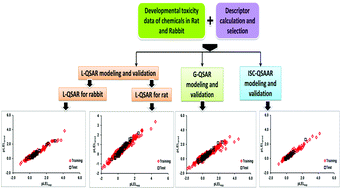In silico prediction of the developmental toxicity of diverse organic chemicals in rodents for regulatory purposes†
Abstract
The experimental determination of the developmental toxicity potential (LEL) of chemicals is not only tedious, time and resource intensive, but it also involves unethical tests on animals. In this study, we have established quantitative structure activity relationship (QSAR) models for predicting the developmental toxicity potential of chemicals in rodents following the OECD guidelines. Accordingly, decision tree forest (DTF) and decision tree boost (DTB) based local (L-QSAR), global (G-QSAR) and interspecies quantitative structure activity–activity relationship (ISC QSAAR) models were developed for estimating the LEL (lowest effective level) dose of chemicals for developmental toxicity in rats and rabbits. The structural features of chemicals responsible for developmental toxicity in rodents were extracted and used in QSAR/QSAAR analysis. The external predictive power of the developed models was evaluated through the internal and external validation procedures. In test data, the L-QSAR models (DTF, DTB) yielded R2 values of >0.846 (rat) and >0.906 (rabbit), whereas in G-QSAR, the correlation value was >0.870 between the measured and predicted endpoint values. In ISC QSAAR models, the R2 values in test data were 0.830 (DTF) and 0.927 (DTB), respectively. Values of various statistical validation coefficients derived from the test data (except rm2 in DTF based rat L-QSAR and ISC QSAAR models) were above their respective threshold limits, thus putting a high confidence in this analysis. The prediction quality of the developed QSAR/QSAAR models was also assessed using the mean absolute error (MAE) criteria and found good. The applicability domains of the constructed models were defined using the descriptor range, leverage, and standardization approaches. The results suggest that the developed QSAR/QSAAR models can reliably predict the developmental toxicity potential of structurally diverse chemicals in rodents, generating useful toxicity data for risk assessment in humans.


 Please wait while we load your content...
Please wait while we load your content...